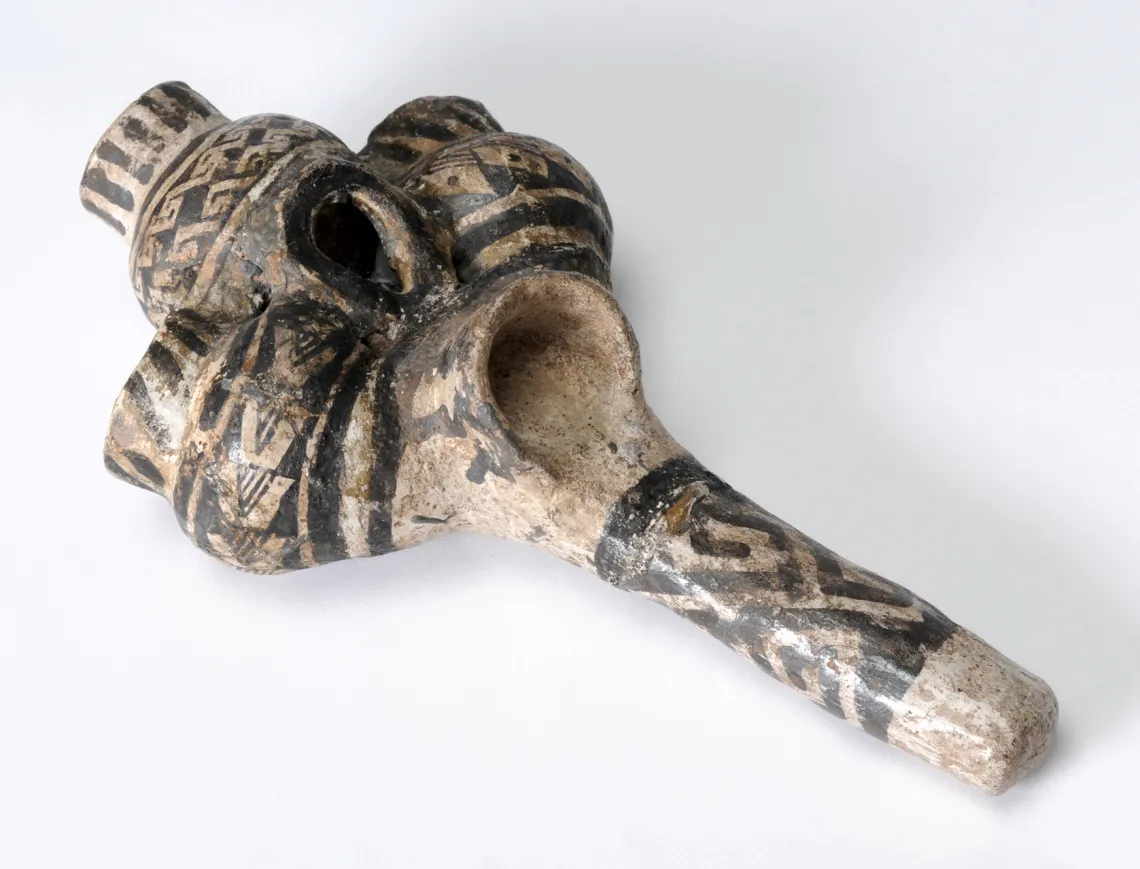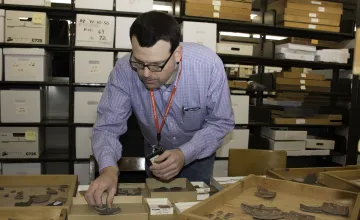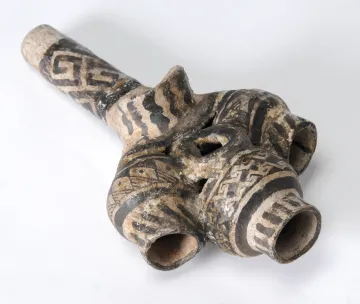
Pinedale Black-on-white Burden Basket Effigy
1270–1320 C.E.
Anasazi (Ancestral Pueblo)
Late Pueblo III Period–Early Pueblo IV Period
Showlow Ruin, AZ P:12:3(ASM), East-Central Arizona
Ceramic
Length: 7.5 in. (18.9 cm.), Width: 3.9 in. (9.8 cm.), Height: 2.4 in. (5.9 cm.)
Gift of Gila Pueblo Archaeological Foundation, 1950
(ASM Catalog No. GP6788)
This object was excavated from the Showlow Ruin (Holbrook:12:2[GP]; AZ P:12:3[ASM]) by a member of the Whipple family, who owned the site. The artifact was then sold to a person identified in collections records only as “L. Jennings.” Gila Pueblo Archaeological Foundation then bought the object from Jennings in 1928, adding it to their collections for the purpose of research.
Prehispanic objects are no longer purchased by most museums as this practice encourages the looting of archaeological sites and contributes to the loss of irretrievable information about the past. When Gila Pueblo Archaeological Foundation dissolved, in 1950, all of its collections—including this object—were donated to the Arizona State Museum (ASM).
Besides the example from Showlow Ruin, which dates to the late 1200's or early 1300's C.E., ASM curates very early specimens, lacking attached vessels, from the Prayer Rock District of northeastern Arizona. These early specimens most likely date to the period between 600 and 700 C.E., indicating that the traditions associated with these objects were long-lived.
This object is most interesting to me, an archaeologist who studies ancient migrations, because it is a clue marking the movement of people. Such migrations created the ethnically diverse late prehispanic communities that were directly ancestral to the Pueblo Indians who live in the region today.
* Menstrual aprons are thong-like woven garments stained with traces of menstrual blood.
References
Printing this page will display URLs for links to citations.
Byers, Douglas S., and Noel Morss
- 1957 Unfired Clay Objects from Waterfall Ruin, Northeastern Arizona. American Antiquity 23(1):81-83.
Chapman, Kenneth M.
- 1966 Three Ceremonial Objects. El Palacio 73(3):31.
Guernsey, Samuel J.
- 1931 Explorations in Northeastern Arizona: Report on the Archaeological Fieldwork of 1920–1923. Papers of the Peabody Museum of American Archaeology and Ethnology, Vol. XXII(1). Harvard University, Cambridge.
Haury, Emil W., and Lyndon L. Hargrave
- 1931 Recently Dated Pueblo Ruins in Arizona. Smithsonian Miscellaneous Collections 82(11).Smithsonian Institution, Washington, D.C.
Judd, Neil M.
- 1954 Material Culture of Pueblo Bonito. Smithsonian Miscellaneous Collections, Volume 124. Smithsonian Institution, Washington, D.C.
See pages 316-320, Plate 88, and Figure 100
Full text viewable online from the University of Virginia Library.
Lyons, Patrick D.
- 2003 Ancestral Hopi Migrations. Anthropological Papers of the University of Arizona No. 68. University of Arizona Press, Tucson.
Morris, Earl H.
- 1927 The Beginnings of Pottery Making in the San Juan Area: Unfired Prototypes and the Wares of the Earliest Ceramic Period. Anthropological Papers of the American Museum of Natural History, Volume XXVIII(2). American Museum of Natural History, New York.
See page 154 and Figure 6f
Full text version available online from the American Museum of Natural History Research Library
Morris, Earl H., and Robert F. Burgh
- 1941 Anasazi Basketry, Basket Maker II Through Pueblo III: A Study Based on Specimens from the San Juan River Country. Publication 533. Carnegie Institution of Washington, Washington, D.C.
Morris, Elizabeth Ann
- 1980 Basketmaker Caves in the Prayer Rock District, Northeastern Arizona. Anthropological Papers of the University of Arizona No. 35. University of Arizona Press, Tucson.
Tanner, Clara Lee
- 1976 Prehistoric Southwestern Craft Arts. The University of Arizona Press, Tucson.







